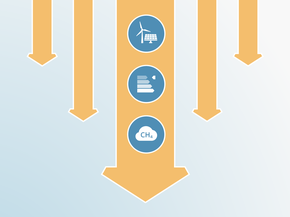Country summary
Overview
China’s emissions under current policies remain sky high with no sign of substantial emission reductions before the 2030 peaking timeline, putting one of the country’s NDC targets in jeopardy. Energy and electricity demand forecasts continue to grow, prolonging China's dependence on fossil fuels, despite substantial progress in renewables and end use sectors.
The government continues to champion the role of fossil fuels in transitioning its energy sector, with maximising coal production and oil and gas exploration seen as key to providing stability and security. Carbon emissions peaking timelines in high-emitting industry sectors have been pushed back to align with the economy-wide 2030 peaking target. The government appears to have room to raise ambition in its climate, energy and sector targets but geopolitics, energy security concerns, and international diplomacy remain a lingering barrier. The CAT’s overall rating for China’s policies and targets remains “Highly insufficient”.
In a year where China’s economy slowed from zero-COVID policies and subdued industrial and transport activity, we estimate China’s emissions in 2022 to have stayed roughly stable at 14.2 GtCO2e. China has continued to stockpile coal at record rates although consumption, the direct link to emissions, remains uncertain.
According to our analysis, emissions are expected to peak around 2025 and plateau at high levels for the rest of the decade. We have revised absolute emission levels in 2030 upward by 2-5% in 2030 compared to our previous assessment, meaning that China’s climate and energy policies are not strong enough to drive down emissions.
As in previous years, the analysis shows emission levels under domestic policies to be lower compared to China’s energy-related NDC targets. We project China to comfortably overachieve its non-fossil energy share and renewable capacity targets without substantially increasing its current mitigation efforts, despite an increased emissions trajectory.
However, a less optimistic economic forecast coupled with high emissions in 2030 puts China in danger of missing its carbon intensity NDC target for the first time since the Paris Agreement. To strengthen its climate policy to and keep emissions in line with China’s 2060 carbon neutrality target, China could:
- Control and reduce energy demand and fossil fuel dependence as energy demand is projected to rise by over 12% in 2030 compared to 2021 levels, at a pace where clean energy developments are unable to meaningfully bring down emissions. High-level political signals including President Xi Jinping’s speech at the 20th CPC National Congress, the 2023 Government Work Report from the “Two Sessions” (annual plenary sessions of two of China’s major political bodies), and strategies from national planning and energy institutions, all emphasise China’s energy security as the first order concern. Production and mining of coal in 2022 were at record high levels, while coal power capacity in the pipeline remains by far the world's largest.
- Improve the formulation and coverage of its climate targets by setting an absolute economy-wide peaking target for greenhouse gas emissions. China’s existing peaking, carbon intensity, and non-fossil energy share targets are relative to economic growth or energy system developments, allowing the country to keep its NDC commitments while increasing emissions levels. The NDC and LTS targets do not directly cover non-CO2 greenhouse gases, which amounts to 2.5 GtCO2e/yr or almost 18% of China’s total emissions.
- Raise the ambition of its energy-related NDC targets: our analysis shows China significantly overachieving the 1,200 GW of wind and solar capacity and 25% non-fossil share target by 2030. Wind and solar capacity is expected to reach northward of 1,900 GW while the non-fossil share is expected to reach around 30%.
- Accelerate decarbonisation of high-emitting industry sectors by pushing up carbon peaking timelines, as well as expanding the ETS sector coverage and improving its design. Industry associations and research from public institutions have suggested earlier carbon peaking timelines were feasible for critical sectors such as cement, steel and non-ferrous metals.
While China’s dependency on fossil fuels and high emission levels looks set to stay for the immediate future, the energy transition and preparation for a post-coal era continues to build momentum, highlighted by high rates of renewable installations and mitigation policices in end-use sectors:
- China’s energy transition investments in non-fossil energy, storage, electrified transport and circular economy remains a global leader, and was larger than the next ten leading countries combined in 2022.
- Installed capacity for renewables has surpassed 1,150 GW, driven by 14th FYP targets such as generating 3300 TWh electricity from renewable sources and having renewables make up at least half of incremental power demand growth by 2025. Half of incremental power demand growth in 2022 was met with wind and solar alone.
- In transport, China exceeded the mark set for its 20% new energy vehicles (mostly electric) market share target in 2025, several years early. A range of industry and buildings sector plans have also been published, with numerous efficiency targets set for 2025.
The CAT rates China’s climate targets and policies as “Highly Insufficient”. The “Highly insufficient” rating indicates that China’s climate policies and commitments are not consistent with the Paris Agreement’s 1.5°C temperature limit and lead to a plateau of high, rather than falling, emissions levels.
China’s climate commitment in 2030 falls between two categories: “Insufficient” and “Highly Insufficient”. The CAT rates China’s commitments as “Highly Insufficient” as emission levels under its NDC commitments are substantially higher than what would be deemed 1.5°C compatible compared to its “fair share” contribution. For the purposes of this rating system, we treat China's NDC commitment as unconditional, as it has not indicated a level of ambition that would be achieved with international support (a conditional NDC target).
China's suite of sectoral 14th Five Year Plans (FYPs) set out a range of mitigation measures to prepare the country for a post-coal transition, but is unable to counter growing energy demand and reduce dependence on fossil fuels.
China’s emissions under current policies are projected to plateau at a high level until 2030 and emissions in 2030 have been raised by 2-5% from the previous CAT assessment, adding an extra burden for reaching long-term carbon neutrality. Under current policies the country is expected to significantly overachieve its energy-related NDC targets but is not yet guaranteed to meet its carbon intensity target. The CAT gives China’s climate policies a rating of “Insufficient”.
China’s climate policies are governed by its Working Guidance for Carbon Dioxide Peaking and Carbon Neutrality and Action Plan For Carbon Dioxide Peaking Before 2030, the “1+N” framework, as well as the 14th Five Year Plans (FYP), which includes energy and carbon intensity reduction targets, as well as targets in energy and end use sectors.
Despite China’s intention to “strictly control coal consumption” before 2025 and to “phase down coal consumption” over the 15th FYP (2026–2030), coal is set to remain the backbone of the energy system as confirmed in the government’s Work Report 2023 and overarching energy documents. Coal production reached record levels in 2022 for the second year running.
Renewables are playing a larger and more obvious role in national energy security, despite the continuing strong focus on fossil fuels. According to the 14th FYPs on energy and renewables, China should reach a 20% non-fossil share in consumption and a 39% share in generation (33% from renewables) by 2025 and have half of all incremental power demand since 2020 come from renewable sources. The country also aims to build 1,200 GW of wind and solar by 2030 and increase its non-fossil share in consumption to 25%. Total renewable capacity reached more than 1,150 GW in 2022.
In the end-use sectors, the government’s new industry peaking implementation plan has aligned the entire sector’s carbon emissions peaking timeline with China’s 2030 NDC target, while the 14th FYP for Green Industry Development has matched the economy-wide energy and emission intensity reduction targets.
Key emitting sectors, such as cement, steel, and aluminium are likely to be the first targeted in the scope expansion of the country’s ETS.
The New Electric Vehicle (NEV) Industry Development Plan (2021-2035) targeted NEV sales to take 20% of the market share by 2025 while the LTS targets 40% by 2030; reports suggest market share already exceeded 25% in 2022 and expected to rise significantly in 2023.
The 14th FYP for Building Energy Conservation and implementation plan sets energy consumption caps in building operations, energy efficiency improvement targets of new public and residential buildings by 20% and 30%, as well as renovation targets.
In the forestry sector, the government has increased efforts on expanding the country’s forestry and grasslands due to its slated role (as carbon sinks) in achieving China’s climate targets; its 14th FYP for forestry and grasslands increases forest coverage targets from 23% in 2020 to 24.1% in 2025.
The full policies and action analysis can be found here.
Under China’s NDC targets, the country’s emission levels would reach 14.0 GtCO2e/year in 2030, an increase of 28% from 2010 levels. The country’s existing policies are set to overachieve the energy-related NDC targets, an indication it could further raise those commitments, but are not yet sufficient to ensure China meets its carbon intensity target.
The CAT keeps its rating of China’s NDC target against modelled domestic pathways in 2030 as “Insufficient”, indicating that its 2030 domestic targets need substantial improvements to be consistent with the 1.5°C temperature limit. If all countries were to follow China’s approach, warming would reach over 2°C and up to 3°C.
This rating takes into account that China would need international support for a fraction of the policy actions required for it to be consistent with the 1.5°C limit.
China’s emission levels under its NDC commitments are substantially higher than what would be deemed 1.5°C compatible compared to our “fair share” approach, resulting in our unchanged fair share rating of “Highly Insufficient”.
The “Highly insufficient” rating indicates that China’s NDC target in 2030 leads to high and plateauing, rather than falling, emissions when compared to its fair share and is not in line with any interpretation of a fair approach to meeting the 1.5°C temperature limit. If all countries were to follow China’s approach, warming could reach over 3°C and up to 4°C.
This rating takes into account the fact that China has effectively submitted an unconditional NDC target but has not indicated a level of emissions that would be achieved with international support (a conditional NDC target). In any event, the present level of unconditional commitment falls substantially short of the commitment that would be consistent with China's fair share contribution to meeting the 1.5°C limit.
China’s President Xi Jinping first announced China’s commitment to reach “carbon neutrality before 2060” in a declaration at the UN General Assembly in September 2020. China has since officially submitted a long-term strategy (LTS) to the UNFCCC in October 2021. As the LTS submission does not meet the majority of our criteria for a best-practice approach in LTS formulation, we keep China’s net-zero target evaluation as “Poor”.
Further analysis
Latest publications
Stay informed
Subscribe to our newsletter




